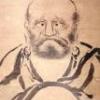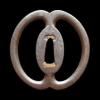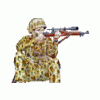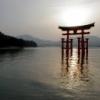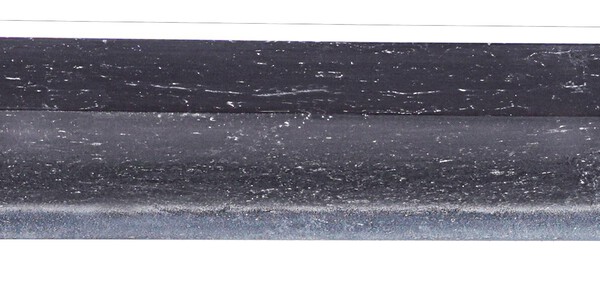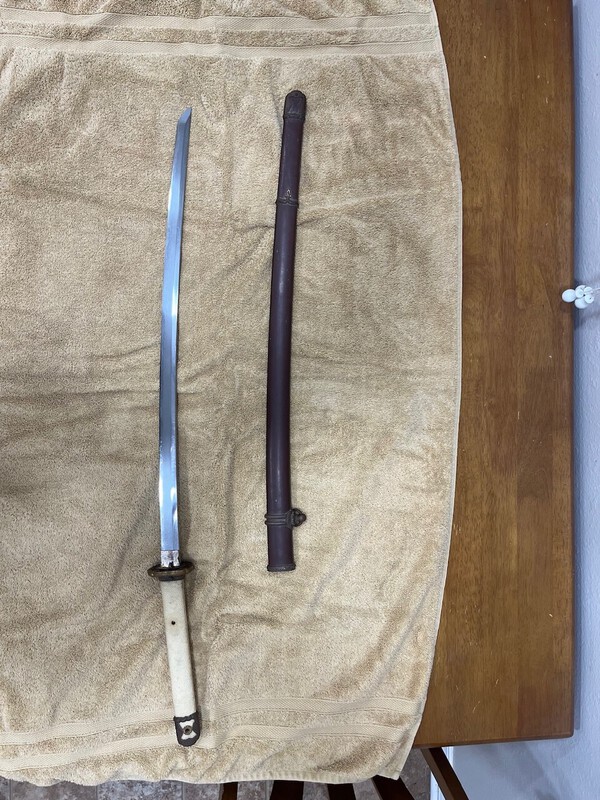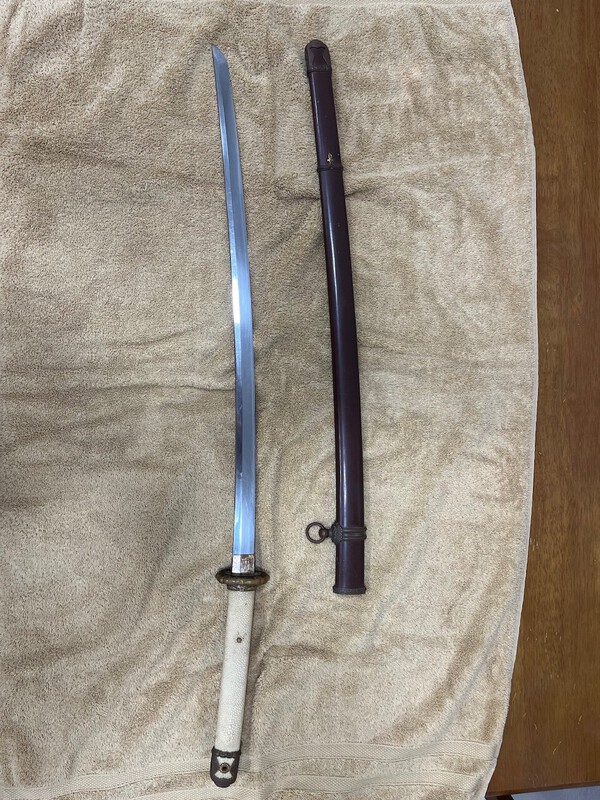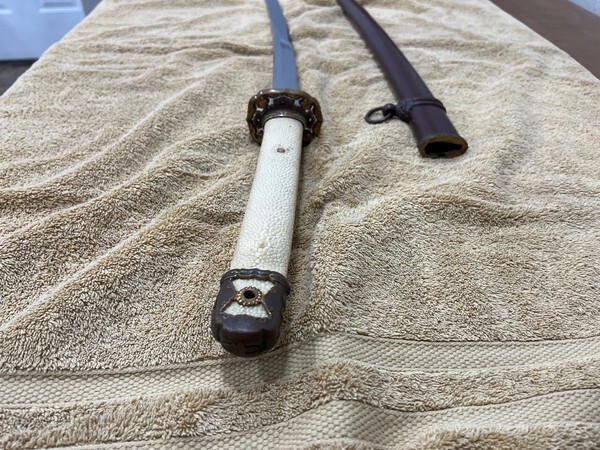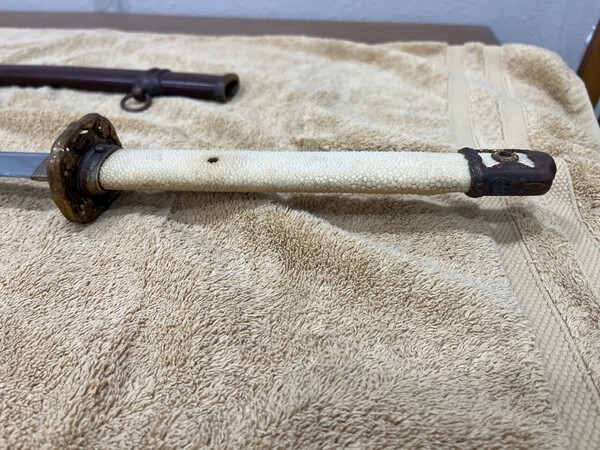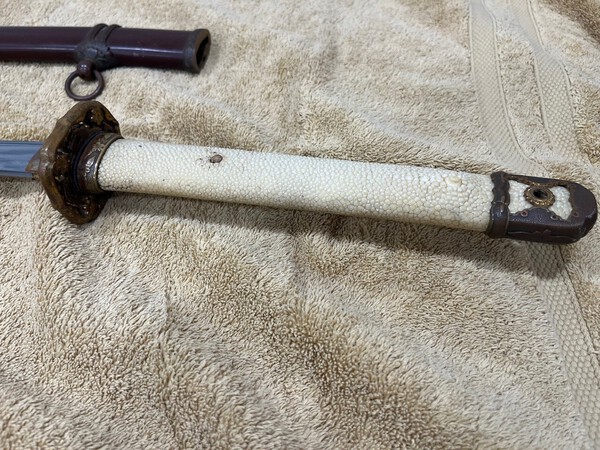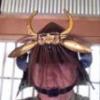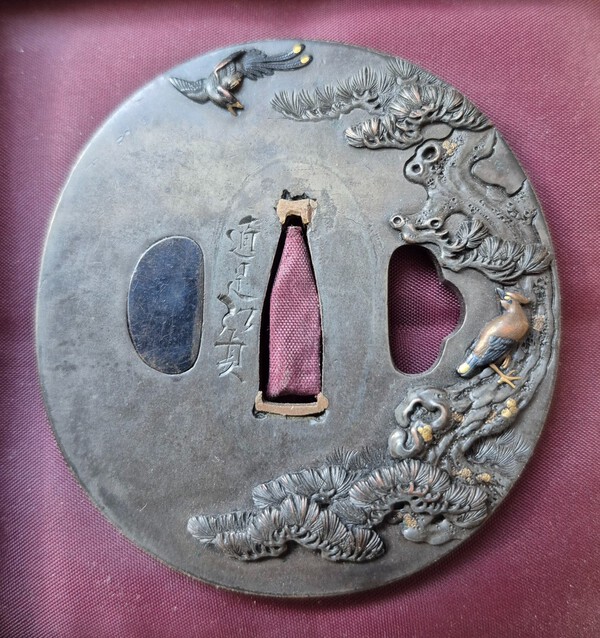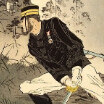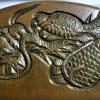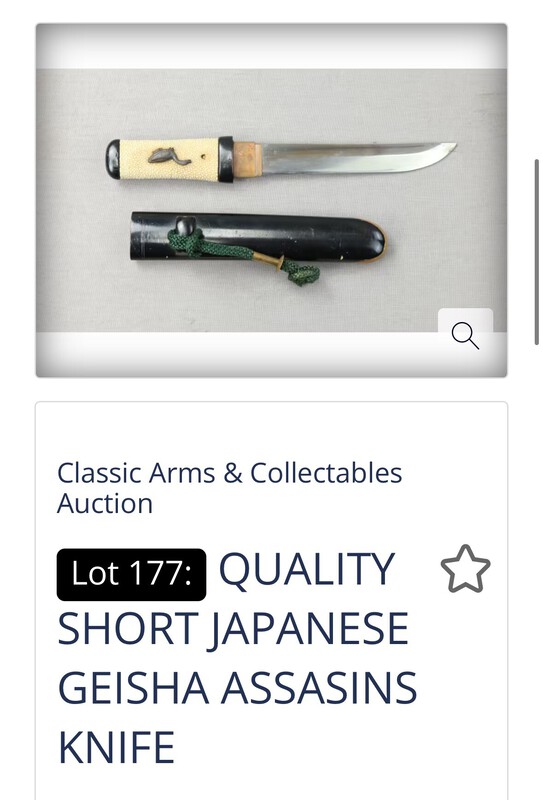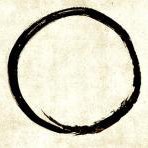Leaderboard
Popular Content
Showing content with the highest reputation on 09/16/2025 in all areas
-
I hate it when auction houses don't post photos of the nakago.3 points
-
Hi Jeff! Marcin gave you a great link, the Ohmura site, for getting to know WWII Japanese swords. As the other guys already pointed out, we could use some clear close up shots of some things to help you get to know your sword a bit better. Here's a great video showing How to Remove the Handled/Tsuka of Japanese Sword Here's a good page to start learning some of the Japanese sword lingo: Japanese Sword Visual Glossary Taking care of your sword: Japanese Sword Care First big step is removing the tsuka (handle) and seeing if your blade is signed and dated. Next is getting a few close, clear shots of the blade's hamon (temper line/pattern), and one shot showing the area around the belt hanger loop (haikan). The Type 94 had 2 haikan, but the second one was removable and is often gone by the time we see them. If it was the 94 version, there might be marks on the saya (scabbard) showing where it sat originally. Otherwise, you have a Type 98. [Mods - I was going to recommend moving this to Military forum, but I guess we might wait to see if the blade is an older nihonto] Oh, and the reason for the comments about "Samurai" are that these fittings were WWII Army, whereas Samurai swords were 'civilian' swords carried by Samurai long before WWII. Now, honestly, though, the Military blades were specifically designed based off the Samurai sword. So, a more technically correct way to refer to them is "Samurai styled sword." Now, it is still quite possible your sword holds a much older blade from the days of the Samurai. So, let's get a look at that nakago (tang)!3 points
-
Type: Tanto Ubu, Suriage or O-Suriage : Ubu Mei : (Mumei, Signature) : Yoshimitsu Era/Age : Shirasaya, Koshirae : shirasaya Nagasa/Blade Length : 8 1/2 inches Sword Location : USA Will ship to : USA Payment Methods Accepted : PayPal Price and Currency : $1200 USD Other Info and Full Description : up for sale is a nice little Tanto signed Yoshimitsu. Nagasa is 8 1/2 inches. The tanto has a suguha hamon that runs the length of the blade. Comes in shirasaya. Pictures in link. https://imgur.com/a/ik6YCal3 points
-
Hi Darren, I'll go first to get the easy bit - the large characters on the right read "Mizusashi": 水指3 points
-
I bought two swords from him in the past: a nanbokucho Tegai Kanetoshi tachi which was a hozon but had him submit for TH, and a hozon zaimei Takada which was to have koshirae made. From there, it was mishap after mishap and a periods of ghosting via email. I had to call a couple of times to get any update. In all, it took nearly two and a half years from purchase to delivery. That said, the descriptions on his website didn't do the swords justice, they were both in amazing condition.2 points
-
2 points
-
I highly doubt they know on how to take them apart .. Well, maybe someone from Australia can help them with description and taking apart plus identification?2 points
-
Very very poor Chinese wallhanger/decorative piece unfortunately. The symbols etc are petty meaningless and pointless to try and give them meaning as this was just made as a trinket/fake.2 points
-
It's the age old question, John. "What came first - the geisha or the assassin?"2 points
-
Quite different. I think the OP's Yoshimitsu is a later generation Tosa Yoshimitsu with a signature stylistically similar to this example. https://www.toukenkomachi.com/index_en_tachi&katana_A111223.html Very nice looking blade for the asking price.2 points
-
2 points
-
I don't think sue Aoe was considered; Regarding the rest I think we are running into competitive nomenclature: when sue Aoe begins, and I am sort at fault for saying "sue Aoe" when I should have used "Muromachi Aoe". Yes, it has rougher jigane compared to Nanbokucho, and can or even expected to have noticably harsher nie activity. (see attached). Some look like Mihara or even Tegai with nijuba, others go all the the way to Yamato Shikkake-Mino with togari etc. Though they are rare, they are also often signed pieces, so no question on attribution. Even with blades from the very end of Nanbokucho (1380s) you have people who continue the tradition, and there are blades reflecting an effort to copy different styles with at times random effect, you see bizarre pieces, but still high quality. Regarding distinctive saka ashi... I can put 10 or 20 images from different blades and while there is this "Aoe" look, whether its saka or not it is not always clear. In real life, depends on polish, lighting, can be even worse. At TJ level there are many pieces which are "classic" Aoe with everything in the book present... When its TH, it all gets murky and Aoe is one school which can be difficult to kantei - jigane varies a LOT, hamon also, and Muromachi pieces you are essentially looking for one or two not too obvious features which confirm its Aoe. Aoe is unfortunately a school which can't be studied by books or even NBTHK newsletter. There is too much variation, and its often difficult to see what you need to see. You speak to people appraising sue Aoe and they say - here is nezumi ashi, saka ashi, but when you look at it - its very subtle, in one place, you show it to another person and he will not see it and will give different appraisal.2 points
-
1 point
-
While surfing a firearms auction - my main interest - I noticed that starting with lot 165 until lot 177 there are a little bit more than 20 blades in this auction. Maybe of interest to some that otherwise would not search there. I can't tell much about the auction company since I have not dealt with them in the past, nor do I know anyone there (for being from the other side of the world). https://auctions.militarylane.com.au/#!/auctions/d7c99452-dfd4-4454-a76a-8ea06e1f9ebf?ic=90&page=21 point
-
I would make the "Downvote" available only to those with a Gold Membership. If you like the suggestion, "Like" it, if you dislike it, "Downvote" it.1 point
-
1 point
-
Someone needs to introduce them to spell checking and proof reading. So many mistakes. The Aussies should be ashamed1 point
-
I think, to some degree, I had that coming. I was ranting about the NBTHK too much, given my own disappointments. I'd previously considered the sukashi and questioned it, but reserved judgement until seeing it in hand. I've seen wider cuts in a lot of old pieces. The nakago ana, I felt was more recent filework from the inside. I see it a bit differently. One point against me is the kozuka ana and how wide it is spaced. I would have to consider if it were added later or original. If original, then I would have to reconsider if I was being a git trying to see it as a ko-tosho. I should put my NBTHK opinions away and try on focus on explaining what I see.1 point
-
1 point
-
1 point
-
I'm confused - used by Geisha who are also assassins or by others to assassinate Geisha?1 point
-
1 point
-
1 point
-
1 point
-
Hi Jeff, Welcome to the forum. Are you able to post a picture of the tang with the handle taken off as there may be a signature and date there?1 point
-
1 point
-
So you finally got yourself a Yasukuni sword, Steve. 👍 Now you don't have to have all those worries about whether it's traditionally made or not. 😁1 point
-
Nicholas, Hope all is well. Beautiful tanto. Does it have NBTHK paperwork for Hozon ? Motokasane measurement ? Sakikasane measurement ? I presume from pictures the habaki is a double habaki and gold foil ? Do you have any closer pictures at all of both sides of the blade ? Also what era roughly is Yoshimitsu ? Muromachi from my research. Found this one on Aoi Art. I presume they are the same. https://www.aoijapan.com/tantoyoshimitsunbthk-hozon-token/ Signatures look to be the same. Thank you for your time in reading and replying. Best regards, Barrett Hiebert1 point
-
Shin gunto T98 with open tsuba [guard] more info after nakago/tang is showed. I don't see signs of it having second hanger/haikan altough chuso is centered. Same about blade itself. There is hamon but close up would help in a matter if it was traditionally made [gendaito] or machine [showato] It's lacking menuki and tsukamaki. But no rust and tip is intact. Rayskin on hundle with full wrap. Have characterisctic lumps [bigger ones closer to pommel are nice to see] http://ohmura-study.net/934.html @Bruce Pennington how often you see seki/showa stamped swords with centered chuso? I wonder if this don't indicate gendaito/pre war sword. In manufacture/factory blades were made in batches. So thinking position of mekugi ana was standardized to speed up production.1 point
-
Ran across the second book at a bookstore this month. Seemed interesting so I thought I would pass it along. I did a NMB search and did not find any mention of either book. https://www.amazon.com/dp/B07MSFQNCR?binding=hardcover&searchxofy=true&qid=1757980878&sr=8-31 point
-
I agree with Uwe, late Edo period. Concerning the rust, knock the lose active red rust off with ivory/bone and then apply oil.1 point
-
1 point
-
1 point
-
I know but one I have in mind also do other services. It was probably Giorgio Movilli. http://www.Japanese-sword.it/index.html Maybe it's time to refresh list? In Europe there are some togishi. And sending to Japan for polish still requires shirasaya. It's owners call. priceLlist_JapaneseSword-2019.pdf1 point
-
Not that it applies to this specific sword... I agree with Bruce, that your blade appears to be Chinese. But, threaded nakago are sometimes found on kyu gunto, and other 'wartime' sabers. So it's not always the "red flag" it might appear to be at first glance. All the best, -Sam1 point
-
For those who are unable to visit the museum in person this might be a worthwhile watch. 2.5 hours split over 2 videos1 point
-
Yasuoki, a lucky day in February 1942 Yasuoki was one of the famous Yasukuni Shrine smiths who worked during the war era. https://www.google.com/search?q=Yasukuni+yasuoki+site%3Awww.militaria.co.za&client=ms-android-google&sca_esv=6b419d715691fe69&sxsrf=AE3TifNOdIuXVStnsrNxL8ac8AzXgKUeSQ%3A1757947355680&ei=2yXIaNueKfLJwt0Ph6eD4AU&oq=Yasukuni+yasuoki+site%3Awww.militaria.co.za&gs_lp=EhNtb2JpbGUtZ3dzLXdpei1zZXJwIilZYXN1a3VuaSB5YXN1b2tpIHNpdGU6d3d3Lm1pbGl0YXJpYS5jby56YUjcLVCFB1jWLXADeAGQAQCYAfsBoAHBD6oBBTAuNi40uAEDyAEA-AEBmAIKoALJDMICChAAGLADGNYEGEfCAgcQIRigARgKwgIFECEYqwLCAggQABiABBiiBJgDAIgGAZAGCJIHBTIuNS4zoAfqLLIHBTAuNS4zuAe3DMIHBzAuMi42LjLIBzM&sclient=mobile-gws-wiz-serp#ip=11 point
-
https://romanceofmen.com/pages/oseppa-in-Japanese-katana-terminology Like this Kai-gunto with the more decorated pattern over a plain core [PS. this image shows the sword was assembled wrong, as it has two O-seppa on the one side of the tsuba! ]1 point
-
1 point
-
No eyebrows, Lewis These split shank rivets are for fastening the shinodare. I stick on my opinion for the time being, Edo period “revival” piece!1 point
-
1 point
-
You would need to post photos of the blade to help narrow down the school & period the sword is from. Otherwise you're basically trying to find an "A.Smith" in the phonebook with no other reference point.1 point
-
1 point
-
Dear All. As far as I can tell I have only heard the term naoshi used when the blade in question has had to be reshaped, not the nakago. As yari mounted as tanto do not need the blade to be reshaped then the term would not apply. I am also puzzled by those examples where the kerakubi would need to have been reshaped quite drastically as I have seen numerous examples where the kerakubi is untouched. Always something new! All the best.1 point
-
0 points
-
Maybe the shinsa team got the insight that the traditional classification system of the pre-Edo works is based on pure speculations…0 points
-
There is a difference between the shinsa team changing every few years, and the Extinction Level event shift somewhere around 2014. After all these years, I still don't know why or how it happened. In a given year, there will be a shinsa or two with some half intelligent results where I think "oh Wow, maybe there is some hope they will return to their Golden Age level". Then the next shinsa or two prove me wrong. It is like the one knowledgeable shinsa NBTHK emeritus judge below Juyo level came in, does a shinsa to keep his "retired but working" NBTHK status, and then leaves the rest of the year to the rubes. It has been over a decade now.0 points
This leaderboard is set to Johannesburg/GMT+02:00

